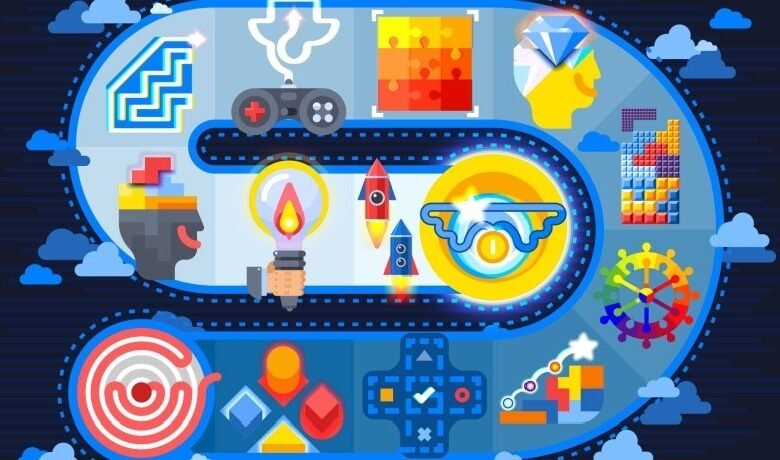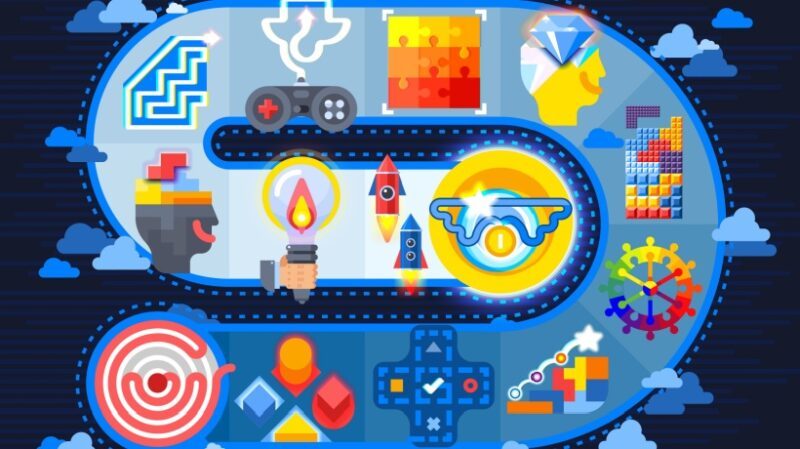Role Of Gamification In Corporate Learning


Role Of Gamification In Corporate Learning
Corporate learning has seen a tremendous shift from traditional pedagogical methods to more technologically advanced approaches. Among these, gamification in learning has emerged as a significant paradigm, proving to be a powerful catalyst in enhancing employee engagement, knowledge retention, and overall training efficacy. But what precisely is gamification, and how does it play a pivotal role in reshaping corporate learning frameworks? This article discusses the subtleties of gamification in the context of corporate learning and why its potential is unparalleled.
Gamification In Learning
Gamification in learning is the use of game design elements and mechanics in nongame contexts, like employee training programs, to foster engagement, motivation, and participation by relying on inborn human tendencies towards competition, achievement, and teamwork. Common features in gamified learning environments include point systems, leaderboards, badges, levels, and progress tracking, mimicking video games to make the experience interactive and engaging.
In corporate learning, gamification bridges the gap between theoretical instruction and practical application. It provides learners with a dynamic platform to develop skills, acquire knowledge, and practice decision-making in a risk-free virtual environment. For example, sales professionals can engage in simulated customer interactions, honing their persuasion skills while navigating various scenarios. By incorporating these interactive components, gamification elevates the learning experience to be more memorable and impactful.
The Psychology Behind Gamification
The gamification process in learning works effectively because it aligns with psychological principles, primarily those concerning motivation and behavior. Cognitive theories, such as self-determination theory (SDT), suggest that humans require autonomy, competence, and relatedness. These needs are satisfied through gamified training programs by allowing employees to control their learning experience (autonomy), showing them that they can excel at their tasks (competence), and by involving them in group exercises to promote relationships with others (relatedness).
Furthermore, gamification reward systems activate the brain’s dopamine pathway. When employees attain milestones, collect badges, or move up a leaderboard, dopamine (a neurotransmitter that signals pleasure and motivates) is released within their brains. Such a neurochemical response reinforces positive behavior, motivating learners to continue with their training and perform exceptionally well in their roles.
Core Roles Of Gamification In Corporate Learning
1. Increasing Involvement And Participation
One of the most significant advantages of gamification in learning is its ability to capture learners and keep them interested. Traditional training methods are often boring lectures or static eLearning modules, which result in disengagement and cognitive fatigue. In contrast, gamified solutions provide interactive and immersive experiences that keep employees’ attention.
For instance, a gamified compliance training program may provide the employees a series of challenges to be completed, with points achieved by unlocking different levels. That’s not all; this technique also gamifies routine tasks to make them interesting activities for employees.
2. Knowledge Retention
Retaining knowledge is a basic objective of corporate training. Gamification enhances the retention of information through the engagement of multiple sensory and cognitive pathways. The interactive scenarios, quizzes, and simulations that characterize gamified programs allow learners to apply theoretical knowledge in operational contexts. Moreover, gamified training follows an iterative nature, by revisiting topics through challenges or assessments to enhance memory consolidation.
3. Collaboration And Team Dynamics
Corporate success is often achieved by effective collaboration. Learnings employing gamification encourage such an environment by including cooperative aspects within training programs. This includes features such as team-based challenges, group exercises in problem-solving, and group leaderboards, promoting the idea of camaraderie between colleagues trying to reach common goals.
For example, a leadership development program may be a team-based simulation where participants have to navigate complex business scenarios that demand collective decision-making and strategic thinking. Such activities enhance interpersonal skills while reinforcing the importance of collaboration in achieving organizational objectives.
4. Providing Real-Time Feedback
Traditional training methods do not have the mechanisms for immediate feedback, and employees are left in the dark until post-training evaluations. Gamified systems, on the other hand, provide real-time feedback through interactive dashboards, progress bars, and performance analytics. This instant feedback loop empowers employees to identify areas for improvement and adjust their strategies accordingly.
The other advantage gamification offers organizations is actionable insight into training effectiveness. Learning from data generated on gamified platforms enables companies to measure learner progress, identify knowledge gaps, and align their training initiatives better for organizational objectives.
5. Motivation Through Rewards
Incentives form the backbone of gamification in learning. It rewards employees with points, badges, certificates, or tangible rewards to tap into both extrinsic and intrinsic motivators. These rewards make the learners feel accomplished and encourage positive behaviors, sustaining engagement with the training programs.
Furthermore, the gamification element of competition—leaderboards—motivates workers to perform at their best by leveraging the competitive nature of individuals. A competition among colleagues can enhance participation rates and positive performance results.
Case Studies Demonstrating Gamification’s Impact
Many companies have utilized gamification in corporate learning contexts with groundbreaking success. Some examples include:
- A global tech conglomerate
This organization harnessed gamification for upskilling the global workforce on cybersecurity awareness. It made a training program that included simulated phishing attacks, interactive quizzes, and a leaderboard. The security breach rates were reduced by 30% within 6 months. - A retail giant
This retail giant offered a gamified approach with role-playing scenarios and some type of rewards system to develop better customer service skills. Within the first year, employees’ satisfaction levels improved by 25%, and customer complaints dropped drastically.
Concerns And Opportunities
While gamification in learning offers numerous benefits, this does not necessarily mean that it is devoid of challenges in implementation. It is important to align gamified training programs with business objectives. Poorly executed gamification, such as those with excessive competition or worthless rewards, leads to counterproductive results, such as disengagement or frustration.
The technological underpinning required for gamification may be difficult for some companies to finance or implement logistically. It becomes crucial to acquire robust Learning Management Systems that support gamified capabilities for the free and smooth deployment of such applications in a scalable manner.
Finally, there must be a balance between the game mechanics and the learning content. The games should support the learning but not overshadow it. Over-gamification of a training program reduces it to pure entertainment rather than an educational offering.
Future Of Gamification In Corporate Learning
Further expansion in the role of gamification in corporate learning could be forthcoming as technology continues to advance. It is through Augmented Reality (AR), Virtual Reality (VR), and Artificial Intelligence (AI) that new training programs will revolutionize the gamified approach toward more immersive, unique, and individualized knowledge acquisition processes.
For example, VR-based gamification may enable an employee to test themselves through a high-stakes decision-making simulation, and AI-powered platforms can use the individual performance of a learner to calibrate challenges. All of these developments promise to make corporate training effective, engaging, and future-ready.
Besides, lifelong learning and upskilling have gained increasing importance in today’s fast-paced work environment. Continuous learning initiatives where gamified elements are incorporated can help an organization create a culture of curiosity and innovation, equipping employees to thrive in an ever-changing landscape.
Conclusion
Learning gamification has evolved from being a new concept to become the backbone of modern corporate training strategies. Gamification enhances engagement, improves knowledge retention, encourages collaboration, and fosters motivation, thus enabling organizations to create impactful and long-lasting learning experiences. Gamified elements in training programs can revolutionize workforce development.
However, for it to be implemented effectively, it has to be well planned and aligned with the goals of the organization. It needs an unrelenting commitment to balancing entertainment and education. As technology continues to evolve, so will gamification, and it will surely be a significant factor in corporate learning, making tomorrow’s workforce precise and effective.
Originally published on January 31, 2025
Source link





